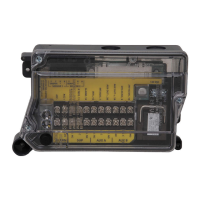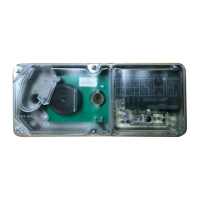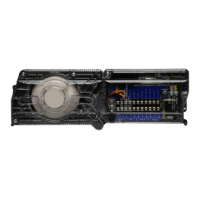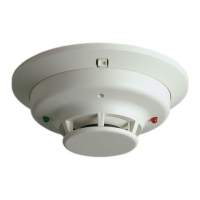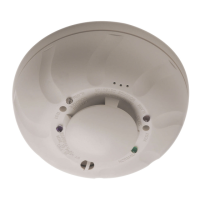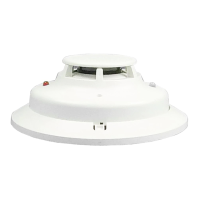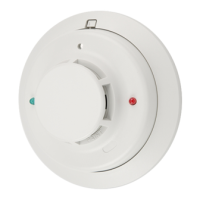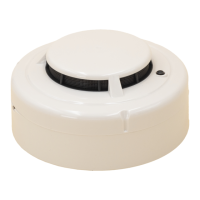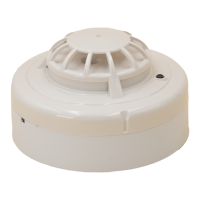Wiring Instructions
The DH100ACDCLP detectors are designed for easy wiring.
The housing provides a terminal strip with clamping plates.
Wiring connections are made by stripping about
3
/8″ of insu-
lation from the end of the wire, sliding the bare end under
the plate, and tightening the clamping plate screw.
[5.7] Perform Detector Check
1. Perform STANDBY AND TROUBLE TEST per Section
[6.2.1].
2. Perform MAGNET TEST per Section [6.2.2.1]. The
RTS451 test of Section [6.2.2.2] may substitute for this
requirement.
3. Perform AIR FLOW TEST per Section [6.1.1].
4. Perform SMOKE RESPONSE TEST per Section [6.1.2].
5. Perform SENSITIVITY TEST per Section [6.2.3].
[5.8] Install The Cover
Install the cover using the six screws that are captured in
the housing cover. Be certain filters are installed as speci-
fied in Section [5.5]. Make sure that the cover fits into the
base groove and that all gaskets are in their proper posi-
tions. Tighten the six screws.
[6] Duct Smoke Detector Maintenance And Test
Procedures
Test and maintain duct smoke detectors as recommended
in NFPA 72. The tests contained in this manual were
devised to assist maintenance personnel in verification of
proper detector operation.
Before conducting these tests, notify the proper authorities
that the smoke detection system will be temporarily out of
service. Disable the zone or system under test to prevent
unwanted alarms.
[6.1] Smoke Entry Tests
[6.1.1] Air Flow
The DH100ACDCLP is designed to operate over an extended
air speed range of 100 to 4000 FPM. To verify sufficient sam-
pling of ducted air, turn the air handler on and use a
manometer to measure the differential pressure between the
two sampling tubes. The differential pressure should meas-
ure at least 0.0015 inches of water and no more than 1.2
inches of water. Because most commercially available
manometers cannot accurately measure very low pressure
differentials, applications with less than 500 FPM of duct air
speed may require one of the following: 1) the use of a cur-
rent-sourcing pressure transmitter (Dwyer model numbers
607-1 or 607-01) see field bulletin Z75-79-00 or; 2) the use
of aerosol smoke per section 6.1.2.
[6.1.2] Air Flow Test using Aerosol Smoke
Drill a
1
⁄4″ hole 3 feet upstream from the duct smoke detec-
tor. With the air handler on, measure the air velocity with
an anemometer. Air speed must be at least 100 FPM. If the
air speed is greater than 500 FPM, use a conventional
manometer to measure differential pressure between the
sampling tubes.
Spray aerosol smoke* into the duct through
the
1
⁄4″ hole for five seconds. Wait two minutes for the duct
smoke detector to alarm. If the duct smoke detector alarms,
air is flowing through the detector. Remove the duct smoke
detector cover and blow out the residual aerosol smoke from
the chamber and reset the duct smoke detector. Use duct
tape to seal the aerosol smoke entry hole.
*Aerosol smoke can be purchased from Home Safeguard Industries,
Malibu, CA. Phone: 310/457-5813.
To determine if smoke is capable of entering the sensing
chamber, visually identify any obstructions. Plug the
exhaust and inlet tube holes to prevent ducted air from car-
rying smoke away from the detector head, then blow smoke
such as cigarette, cotton wick, or punk directly at the head
to cause an alarm. REMEMBER TO REMOVE THE PLUGS
AFTER THIS TEST, OR THE DETECTOR WILL NOT FUNC-
TION PROPERLY.
[
6.1.3] Filter Replacement
The filters do not substantially affect smoke performance
even when up to 90% of the filter is clogged. Quarterly
visual inspection usually suffices to determine whether the
filters should be replaced because only a high percentage of
contamination affects performance. If further testing is
required, compare differential pressure readings with and
without the filters installed. If the difference exceeds 10%
replace the filters. In no case should the pressure differen-
tial fall below 0.0015 inches of water.
[
6.2] Standby, Alarm and Sensitivity Tests
The cover must be removed to perform these tests. The use
of a remote accessory for visible indication of power and
alarm is recommended.
[6.2.1] Standby And Trouble
Standby — Look for the presence of the flashing green LED. The
LED should flash approximately every 10 seconds.
Trouble — If the detector LED does not flash, then the detec-
tor lacks power (check wiring, panel, or power
supply), the detector board is missing (replace),
the cover has been missing or not secured proper-
ly for more than 20 minutes (secure cover proper-
ly), or the unit is defective (return for repair).
Test — The trouble condition can be caused intentionally
to verify correct operation of the system. Remove
the detector board to cause a trouble condition
locally and at the system control panel.
D200-14-00 5 I56-0084-00
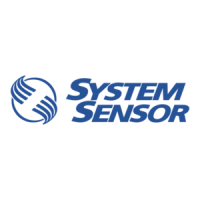
